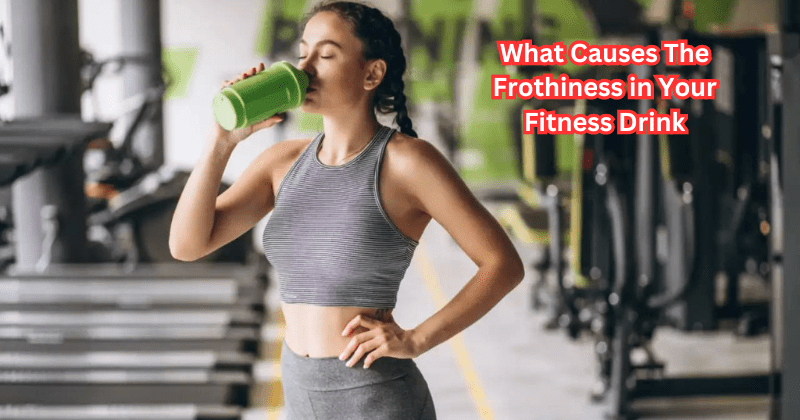Understanding the science behind the frothiness in your fitness drink unveils a fascinating interplay of ingredients, techniques, and chemical reactions that contribute to this common phenomenon.
The frothy layer atop your beverage is not merely a visual spectacle but a result of various factors. From the protein molecules interacting with air bubbles to the mixing intensity and type of ingredients used, each element influences the formation of foam.
Delving into what causes this frothiness can provide insights into how to adjust your preparation methods, optimize your drink's texture, and enhance your overall drinking experience.
Join us on a journey to unravel the secrets behind the frothy allure of your fitness drink.
What is Frothiness?
Frothiness refers to the foamy layer that forms on top of a drink, often characterized by small bubbles and a light, airy texture. This foam is usually seen in drinks with milk or protein-based ingredients and can range from delicate layers to thick and creamy textures.
While frothiness is commonly associated with coffee-based beverages like cappuccinos and lattes, it's also prevalent in fitness drinks such as protein shakes, smoothies, and energy drinks.
As the protein unwinds, hydrophobic and hydrophilic ends of the molecule interact with both water and air, creating a stable foam layer on top of your drink. This process is denaturation and plays a significant role in achieving frothiness.
Understanding the Science Behind Foamy Smoothies
The scientific explanation for the frothiness in your fitness drink lies in the process of aeration. Aeration refers to the incorporation of air into a liquid, creating tiny bubbles that form foam on the surface. In simpler terms, it is essentially whipping air into your beverage, resulting in that light and airy texture.
This process is essential for many drinks like lattes, cappuccinos, and smoothies as it enhances their sensory experience by adding volume and mouthfeel. However, when it comes to fitness drinks, aerating plays an even more critical role.
What Causes The Frothiness in Your Fitness Drink?
Now that we understand the basic science behind foam formation let's take a closer look at what causes the frothiness of your fitness drink. Here are some factors that contribute to this phenomenon:
Proteins: The Key Player
Proteins play a vital role in the formation of foam in your fitness drink. Protein molecules have hydrophobic (water-repelling) and hydrophilic (water-loving) parts. When proteins come in contact with water, they arrange themselves at the surface of the liquid, with their hydrophobic ends facing up towards the air and their hydrophilic ends facing down towards the liquid.
When air is mixed into the drink, it gets trapped between these proteins, creating a stable and airy foam layer. The more protein there is in your beverage, the thicker and longer-lasting the foam will be.
Mixing Techniques: The Art of Whipping
The way you mix your fitness drink can also significantly impact its frothiness. Vigorous shaking or blending introduces more air into the drink, resulting in a thicker foam layer. This can be beneficial for some drinks like smoothies, where a thicker foam can provide a creamier texture.
On the other hand, gentle stirring or swirling may not produce as much foam but can create smaller and more stable bubbles, giving your drink a smoother mouthfeel. It all depends on the type of drink you are preparing and your personal preference.
Finding the Right Balance of Liquid in Your Smoothie
Another essential factor in achieving the perfect foam is finding the right balance of liquid in your smoothie. If you have too little liquid, you won't have enough surface tension to trap air bubbles, resulting in a flat drink. On the other hand, too much liquid can dilute the proteins and limit their ability to form a stable foam layer.
The Role of Ingredients in Foamy Drinks
The ingredients you use also play a significant role in the frothiness of your fitness drink. Milk, for example, contains proteins that can denature and create foam when heated or aerated. Almond milk is another popular alternative that can produce a similar effect. Like proteins, fats also have hydrophobic properties, which contribute to foam formation.
Other ingredients like bananas, avocado, and yogurt can also contribute to foaming due to their high protein content. Experimenting with different ingredients can help you find the perfect balance of flavors and frothiness in your drink.
These are just some of the many factors that can influence the frothiness in your fitness drink. By understanding how each element contributes to foam formation, you can adjust your preparation methods and ingredients to achieve the ideal texture and mouthfeel for your beverage.
Tips for Achieving Frothy Perfection
Now that we know what causes the frothiness in our fitness drinks, let's look at some tips for achieving that perfect foam:
- Start with cold liquids: Cold liquids hold air bubbles better, resulting in a thicker and more stable foam layer.
- Use a blender: Blending your drink can introduce more air into the mixture, creating a frothier texture.
- Don't overblend: While blending is essential for aerating your drink, overdoing it can break down proteins and result in less foam.
- Experiment with different ingredients: As mentioned earlier, different ingredients can have varying effects on foam formation. Be open to trying new combinations to find the perfect balance of flavors and frothiness.
- Practice makes perfect: Achieving the right amount of frothiness may take trial and error. Keep experimenting with different techniques and ingredients until you find what works best.
Now that you have a deeper understanding of the science behind frothy fitness drinks, you can impress your friends and family with your knowledge at the next smoothie-making session.
Is Foaming in Whey Protein Shake Causing You A Concern?
Some fitness enthusiasts may have concerns about the foam in their whey protein shake. Fear not, as it is a natural occurrence and does not affect the nutritional value of your drink. However, if you find the frothiness unappealing or bothersome, there are a few things you can try:
- Let your shake sit for a few minutes before consuming. This will allow the foam to settle on top, making it easier to skim off or pour.
- Use less water when mixing: As mentioned earlier, too much liquid can dilute proteins and limit foam formation. Using less water can result in less frothy shakes.
- Try different shaking techniques: As with smoothies and other fitness drinks, shaking methods can significantly impact foam formation. Experiment with different techniques until you find what works best for you.
Remember, the foam in your whey protein shake is completely normal and does not affect the nutritional value or taste of your drink. However, if it bothers you, these tips can help you achieve a less frothy shake.
FAQs
What causes the frothiness in whey protein shakes?
The frothiness in whey protein shakes often results from the air incorporated into the shake during blending. Whey protein, especially in forms like whey protein concentrate, contains proteins that can coagulate and trap air, leading to a foamy texture.
How do amino acids and protein structure contribute to foam formation in protein drinks?
In whey protein powder, amino acids are tightly coiled within the protein structure. When mixed, this chain partly unwinds, allowing the proteins to coagulate and trap air, which contributes to the frothiness of the drink.
Can the way I mix protein powder affect the frothiness of my drink?
Yes, the method used to mix protein powder can significantly affect frothiness. Vigorous shaking or high-speed blending introduces more air, increasing foam formation. For a foam-free protein shake, gently stir the protein powder into your liquid of choice.
Are there any types of protein powders that are less likely to create a foamy drink?
Foam formation is more common with certain types of protein powders like whey protein concentrate due to its coagulation properties. Opting for protein powders designed to be foam-free, or those that emphasize smooth mixing, can help reduce frothiness in your protein drinks.
Conclusion
In conclusion, the frothiness in your fitness drink is a delightful fusion of science and artistry, influenced by the intricate dance of ingredients, mixing techniques, and chemical reactions. Understanding the factors that contribute to this frothy phenomenon empowers you to enhance the texture, flavor, and overall appeal of your beverage.
By mastering the balance of protein composition, aeration methods, and ingredient selection, you can craft a drink that not only tantalizes the taste buds but also delivers visual appeal. Embrace the frothiness as a testament to the complexity and creativity inherent in fitness drinks, elevating your drinking experience to new heights.

Click Here to Learn More About the Rip Toned Supplements

